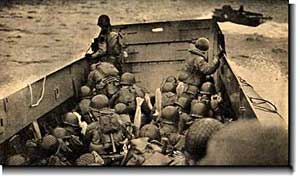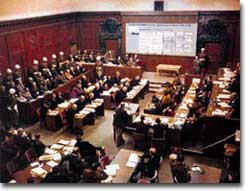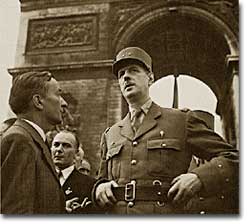| HOME |
By the summer of 1944, Hitler's Nazi empire was diminished, pushed backward toward Berlin by American, British, Soviet, and even Italian forces. The Allies' heroic D-Day invasion of France on June 6, 1944, was the beginning of the end of that empire. In less than a year, Allied forces and the Soviet Red Army would converge on Berlin. As the Allies began their slow and costly march through Italy, they met fierce resistance from German troops who could no longer count on Italy to support them. But in May 1944 Allied forces broke through the "Gustav line" of Nazi defenses, situated just north of Naples. And on June 4, the Allies liberated Rome. The fight for Italy continued until April 1945, when the stubborn German Field Marshal Albert Kesserling finally surrendered. The retaking of Italy was important, but the priority of Allied commanders was cracking Hitler's "Atlantic Wall" along the coast of France. Reflecting the Americans' rising importance in the war, in January 1944, Dwight D. Eisenhower took command at Supreme Headquarters in London and began planning Operation Overlord, the crossing of the English Channel to liberate France.
An elaborate game of espionage, counterespionage, and disinformation preceded the D-Day invasion. If the Nazis could learn when and where the invasion would come, they could concentrate their forces there to assure an Allied defeat. The Allies conducted phony military exercises, and even assembled fake tanks to deceive German planes regarding the location of Allied forces. The Germans decided to dig in at Pas-de-Calais, which lay just a short distance from Dover, England. This is precisely what the Allies wanted the Germans to think. Instead of landing at Calais, the Allies surprised Nazi forces by using nearly 5,000 ships to drop 130,000 American, British, and Canadian troops on the beaches of Normandy. First, 23,000 British and American paratroopers dropped behind enemy lines as Allied planes bombarded German beach defenses. The amphibious assault on Omaha, Gold, Juno, Sword, and Utah beaches followed. Americans landing at Omaha beach were hit hard, but by the end of the day the beaches were secured with fewer casualties than feared. Within two weeks, a million men had landed along the coast of France, helped by French resistance fighters who delayed Nazi reinforcements. In August, General George Patton linked with British forces to trap a retreating German army. On August 25, a division of de Gaulle's Free French army, assisted by American forces, liberated Paris after over four years of Nazi rule. By the middle of September 1944, the Nazi stranglehold on France had ended.
But the Germans were not finished. Nazi forces staged one last big offensive, hoping to retake Antwerp, a strategic Belgian port. On December 16, 1944, twelve German Panzer tank divisions penetrated the Ardennes Forest in Belgium and Luxembourg, surprising the Allies. This Battle of the Bulge raged for a month, but a heroic defense by American forces at Bastogne stalled the German advance on December 26. The Battle of the Bulge was the last gasp of a defeated army. As the ground war raged during that winter of 1944-45, civilians in Germany and England became increasingly subjected to retaliatory bombing campaigns. The Allies bombed German factories and transportation links in an effort to cripple the German war economy. Allied bombers also targeted German cities, hoping to break German morale and induce surrender. The bombing of Dresden on the nights of February 13 and 14 was especially ferocious. The air raid created a firestorm that claimed tens of thousands of civilian casualties and terrorized Germany.
As the western Allies advanced through Germany, the Soviet Union was closing in on Berlin from the East. Despite the alliance, there was considerable mistrust between these two groups. Britain, France, and the United States feared that a Soviet occupation of Germany could result in a communist takeover that could spread across war-stricken Europe. Furious at Hitler's betrayal and the catastrophic damage caused by the Nazi invasion, Stalin was determined to extract reparations from Germany. The two sides literally raced each other to the capital. On April 30, 1945, with his enemies just blocks away, Hitler shot himself in his Berlin bunker. Mussolini had been executed by Italian partisans two days earlier. Hitler's dream of building a Greater Germany died with him, as did millions of soldiers and civilians. Finally on May 8, Germany offered an unconditional surrender, ending the nightmare of Hitler's Thousand Year Reich. |
||||||||
| MAIN | |||||||||
| INVESTIGATION CENTRAL | |||||||||
|
|||||||||



